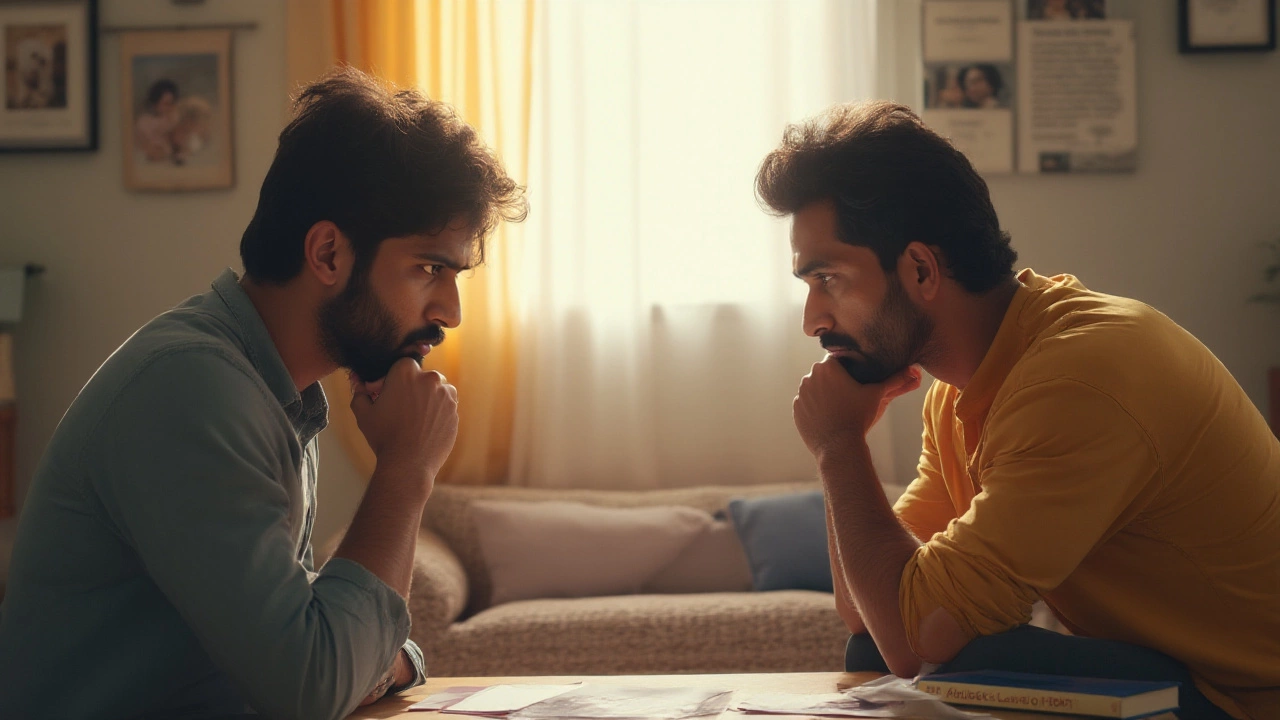If you ask anyone who’s gone through a divorce in India, they’ll tell you—nothing about it is simple. Rumors fly around about how long you need to be separated. Some say it’s set in stone: at least a year apart before you even step into court. But is it really that black and white? Let’s break down what the law actually says, where you might run into unexpected twists, and why some couples manage to speed through while others get stuck waiting, even after the clock runs out.
Understanding the One-Year Separation Rule in Indian Divorce Law
When you look up divorce laws in India, you’ll immediately spot the one-year separation requirement popping up. This rule appears in the Hindu Marriage Act, 1955, and similar rules are in place for other communities under laws like the Special Marriage Act, Indian Divorce Act, and the Parsi Marriage and Divorce Act. The main idea: you can’t file for divorce immediately after your marriage. Legally, at least one year must pass from the date of marriage before you’re even eligible to file a petition for divorce in court.
But what does ‘separation’ really mean here? The catch: you don’t actually need to live in different houses to prove you’re separated. Several courts have held that physical separation isn’t mandatory—as long as you stop living like a married couple, even if you stay under the same roof. Maybe you’ve stopped sharing meals, or there’s no marital relationship and communication. The court will look at the facts, not just your address.
The law spells out this minimum period under Section 13(1)(i-b) of the Hindu Marriage Act. It says that divorce can be granted if the couple has "lived separately for a period of one year or more" immediately before filing the petition. The same goes for mutual consent divorces—Section 13B(1) says both parties must live separately for at least one year before they can jointly file for divorce.
Here’s a fun fact: in the first few decades after India’s independence, the waiting period was even longer—three years under most acts! It was brought down to one year because courts and lawmakers realized dragging an unhappy marriage beyond that made no sense for anyone involved.
What about other religions? Muslim personal law doesn’t really require a fixed separation period for a talaq. Christian couples under the Indian Divorce Act do have a one-year rule, but with some exceptions for cruelty and adultery.
You might be surprised to know that celebrities like Karisma Kapoor and Hrithik Roshan waited out the separation period before their high-profile divorces. Their court documents are public, showing that even wealth and fame can’t skip the legal queue.
When Can Courts Waive the One-Year Separation in India?
Now, you might wonder: is this one-year rule unbreakable? Turns out, it’s got loopholes—but only in exceptional situations. The law provides a way around the mandatory waiting period if you’re dealing with extreme hardship or unusual cruelty.
Under Section 14 of the Hindu Marriage Act, the court can allow you to file for divorce even before you hit the one-year mark. But don’t think it’s as easy as just writing a request. The court only allows this if continuing the marriage would cause “exceptional hardship to the petitioner or exceptional depravity on the part of the respondent.” Domestic violence cases or situations where the spouse disappears might qualify.
Getting this exemption isn’t routine. Courts have made it super clear: the burden is on you to prove your case with strong evidence. For example, if you show police reports, medical records, or clear proof of abuse, you might earn the rare fast-track. But if you just say, “We can’t get along,” that’s not enough.
What about mutual consent divorce? Here, things get interesting. The famous 2017 Supreme Court case, Amardeep Singh v. Harveen Kaur, was a game-changer. The judges ruled that courts can waive the actual six-month cooling-off period for mutual consent divorce (not the one-year separation though), if there’s no hope of reconciliation and all disputes are resolved. Since then, thousands of couples have used this ruling to speed up the process, especially NRIs or people who have been separated for years but only just filed jointly.
If you want a waiver, prepare to support your story with detailed evidence. Lists of emails, text messages, affidavits from family or neighbors, even work records showing you’ve lived apart, all help make your case more believable.
One mistake many make is confusing the six-month ‘cooling-off period’ with the one-year separation rule. The former only applies once you’ve already filed for mutual consent divorce—and now it can often be waived. But that doesn’t affect the minimum year-long separation you need before you can even file.
So, while the law does let you skip the waiting game in urgent situations, judges aren’t handing out waivers unless the break-up is truly catastrophic.

How Separation Is Proved: Evidence that Works (and What Fails)
The next big question: if you’re supposed to be “living separately,” how do you actually prove it in court? What if one person says you’ve split, but the other denies it? Indian courts deal with this all the time, and over the years, some patterns have emerged.
Sharing a flat but living in different rooms doesn’t disqualify your claim. What matters? Everything from testimony, to neighbors’ statements, to written evidence can count. For instance, courts have accepted the following as proof of separation:
- Different bank account transactions showing separate finances
- Aadhaar or utility bills with different addresses
- Tax filings or employment records showing different residences
- Letters, emails, or WhatsApp chats where either spouse admits the separation
- School records showing change of guardian address for kids
Sometimes, parties exaggerate—forgetting that courts can cross-check every claim. If you post a family reunion on Instagram, don’t be shocked if it gets pulled into the proceedings. In high-conflict splits, it’s not uncommon for friends and relatives to be called in as witnesses to back up your story.
One real case from Delhi: a couple lived in the same house but hadn’t shared a meal or spoken for years. Their neighbors and kids testified for both sides. The court ultimately agreed: emotional separation counts, not just physical.
If your spouse contests the separation, the judge will weigh everyone’s statements and look for contradictions. Make sure your story stays consistent across every filing and piece of evidence. Even tiny lies or inconsistencies can make the judge doubt the whole timeline.
Here’s a quick table of typical evidence types and how judges usually see them:
| Evidence Type | Usually Acceptable? | Remarks |
|---|---|---|
| Separate rental agreements | Yes | Best if signed and dated |
| Utility bills at different addresses | Yes | Shows residence, but not absolute |
| Social media posts together | No | May hurt your case |
| Police or legal complaints | Yes | Very strong evidence if filed soon after separation |
| Friend or family testimony | Depends | Better if from neutral third parties |
Some tips: save all important documents from the day you separate, keep receipts if you move out, and avoid posting anything that suggests reconciliation. If you don’t have much written proof, talk to family or friends who can testify to your situation.
Exceptions, Complications, and Special Cases in Indian Divorce Laws
If you think divorce rules are complicated, try dealing with personal laws mixed with religion, location, and family traditions. India’s legal system covers Hindu, Muslim, Christian, Parsi, and civil marriages separately. That means not everyone’s divorce process looks the same.
Here’s a breakdown:
- Muslim Personal Law: No formal separation period required for talaq. But women using the Dissolution of Muslim Marriages Act need grounds—though not a fixed timeline.
- Christians: The Indian Divorce Act requires a year, but also allows exceptions for extreme cruelty or adultery (with court approval).
- Parsis: Also follow the one-year wait, with some leeway in rare cases like disappearance of a spouse for seven years or more.
- NRIs: Many face headaches because they apply for divorce in foreign courts, then need to get it recognized in India. The one-year wait usually applies, unless the foreign court’s laws say otherwise and it’s mutually accepted.
- Desertion or disappearance: If one spouse can’t be found, the court may relax the requirement, but only with public notice and careful investigation.
Mistakes in following the right law are common. Sometimes couples file under the wrong act or forget local rules. Always double-check which law covers your marriage: if you register under the Special Marriage Act, the process can take a different route.
Domestic violence cases often invoke the Protection of Women from Domestic Violence Act, giving courts more room to act quickly and even order separated living before divorce is finalized.
Here’s an example table comparing laws:
| Law | Separation Required | Special Notes |
|---|---|---|
| Hindu Marriage Act | 1 year | Waivers possible for exceptional cases |
| Special Marriage Act | 1 year | Same as Hindu Marriage Act |
| Indian Divorce Act (Christians) | 1 year | Shorter in some cruelty/adultery cases |
| Parsi Marriage and Divorce Act | 1 year | Waivers rarely granted |
| Muslim Personal Law | No fixed period | Depends on talaq process or Dissolution Act |
If your situation is unusual—a spouse abandoned you, remarried secretly, or you married abroad—the best bet is to see a lawyer early. They’ll help you dodge common mistakes like filing too soon or under the wrong section, both of which can get your petition thrown out and force you to start over.

Practical Steps and Real-Life Tips for Navigating Divorce Timelines
Anyone just beginning this process asks the same thing: “Can’t we get this done faster?” Sadly, legal timelines are strict. But understanding the actual process can save months of frustration.
- Start with Documentation: Get marriage certificates, proof of address, ID proof, and anything Linked to separate living ready up front.
- Mutual Consent Divorces Move Quicker: If both agree, and you’ve lived apart for a year, file a joint petition. Be sure issues like alimony, child custody, and asset distribution are ironed out in advance.
- Contested Divorces Take Longer: When only one person wants out, count on a year plus several extra months (sometimes years, depending on backlog and complexity).
- Use the Amardeep Singh Judgment: If you’re filing mutual consent and the cooling-off period is a headache, request a waiver referencing this Supreme Court case. Have proof you’ve been separated and irreconcilable differences are settled.
- Keep Evidence Simple and Consistent: Don’t flood the court with too much or conflicting info. Quality and consistency win over quantity.
- Legal Aid is Available: If you can’t afford a lawyer, free legal services are available at family courts and through the National Legal Services Authority (NALSA).
- Watch for New Rules: Laws change, and sudden tweaks happen. Check the latest court rulings. For example, as of August 2025, no major changes have cut the one-year rule, but local practices may vary.
And here’s a bonus: always stay calm during court proceedings. Judges can sense if tensions are genuine or staged. Trying to rush the process by giving misleading information usually ends up making it longer.
If you’ve been married less than a year and face real hardship, don’t give up hope—you might still qualify, but that path is steep and rocky. Document everything, be honest, and lean on a good lawyer for your best shot at a quick exit.
The legal maze may feel endless, but knowing the true rules—like the one-year separation—protects you from common traps. Whether your goal is speed, fairness, or peace of mind, the right info can turn a messy split into a clean start.
